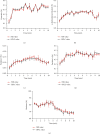Near-Infrared Spectroscopy as a Process Analytical Technology Tool for Monitoring the Steaming Process of Gastrodiae rhizoma with Multiparameters and Chemometrics
- PMID: 33204575
- PMCID: PMC7657684
- DOI: 10.1155/2020/8847277
Near-Infrared Spectroscopy as a Process Analytical Technology Tool for Monitoring the Steaming Process of Gastrodiae rhizoma with Multiparameters and Chemometrics
Abstract
Steaming is a vital unit operation in traditional Chinese medicine (TCM), which greatly affects the active ingredients and the pharmacological efficacy of the products. Near-infrared (NIR) spectroscopy has already been widely used as a strong process analytical technology (PAT) tool. In this study, the potential usage of NIR spectroscopy to monitor the steaming process of Gastrodiae rhizoma was explored. About 10 lab scale batches were employed to construct quantitative models to determine four chemical ingredients and moisture change during the steaming process. Gastrodin, p-hydroxybenzyl alcohol, parishin B, and parishin A were modeled by different multivariate calibration models (SMLR and PLS), while the content of the moisture was modeled by principal component regression (PCR). In the optimized models, the root mean square errors of prediction (RMSEP) for gastrodin, p-hydroxybenzyl alcohol, parishin B, parishin A, and moisture were 0.0181, 0.0143, 0.0132, 0.0244, and 2.15, respectively, and correlation coefficients (R p 2) were 0.9591, 0.9307, 0.9309, 0.9277, and 0.9201, respectively. Three other batches' results revealed that the accuracy of the model was acceptable and that was specific for next drying step. In addition, the results demonstrated the method was reliable in process performance and robustness. This method holds a great promise to replace current subjective color judgment and time-consuming HPLC or UV/Vis methods and is suitable for rapid online monitoring and quality control in the TCM industrial steaming process.
Copyright © 2020 Yamin Zuo et al.
Conflict of interest statement
The authors declare that they have no conflicts of interest.
Figures









Similar articles
-
Near-infrared Spectroscopy as a Process Analytical Technology Tool for Monitoring the Parching Process of Traditional Chinese Medicine Based on Two Kinds of Chemical Indicators.Pharmacogn Mag. 2017 Apr-Jun;13(50):332-337. doi: 10.4103/pm.pm_416_16. Epub 2017 Apr 18. Pharmacogn Mag. 2017. PMID: 28539730 Free PMC article.
-
[Quality evaluation of Gastrodiae Rhizoma standard decoction based on UPLC fingerprint and quantitative analysis multi-components method].Zhongguo Zhong Yao Za Zhi. 2020 Oct;45(20):4909-4917. doi: 10.19540/j.cnki.cjcmm.20200622.303. Zhongguo Zhong Yao Za Zhi. 2020. PMID: 33350264 Chinese.
-
[Correlation between appearance characteristics and intrinsic quality of Gastrodiae Rhizoma].Zhongguo Zhong Yao Za Zhi. 2019 Oct;44(20):4460-4466. doi: 10.19540/j.cnki.cjcmm.20190630.310. Zhongguo Zhong Yao Za Zhi. 2019. PMID: 31872633 Chinese.
-
Characterization of pharmaceutically relevant materials at the solid state employing chemometrics methods.J Pharm Biomed Anal. 2018 Jan 5;147:538-564. doi: 10.1016/j.jpba.2017.06.017. Epub 2017 Jun 15. J Pharm Biomed Anal. 2018. PMID: 28666554 Review.
-
Gastrodiae Rhizoma (tiān má): a review of biological activity and antidepressant mechanisms.J Tradit Complement Med. 2011 Oct;1(1):31-40. doi: 10.1016/s2225-4110(16)30054-2. J Tradit Complement Med. 2011. PMID: 24716103 Free PMC article. Review.
Cited by
-
Development and Validation of Near-Infrared Methods for the Quantitation of Caffeine, Epigallocatechin-3-gallate, and Moisture in Green Tea Production.J Anal Methods Chem. 2021 Nov 15;2021:9563162. doi: 10.1155/2021/9563162. eCollection 2021. J Anal Methods Chem. 2021. PMID: 34820146 Free PMC article.
-
Application of digital-intelligence technology in the processing of Chinese materia medica.Front Pharmacol. 2023 Aug 24;14:1208055. doi: 10.3389/fphar.2023.1208055. eCollection 2023. Front Pharmacol. 2023. PMID: 37693890 Free PMC article. Review.
References
LinkOut - more resources
Full Text Sources
Miscellaneous

